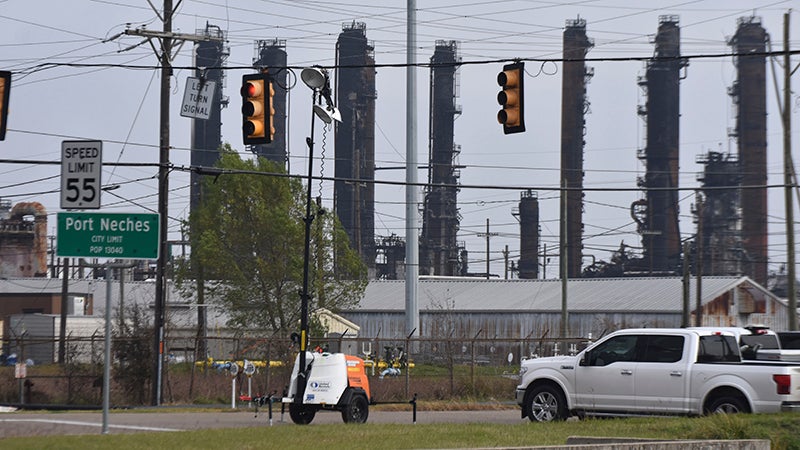Physical, mental concerns continue: TPC Group explosions trigger issues with health
Published 12:16 am Saturday, February 29, 2020

- Charred towers at the TPC Group Port Neches site can be seen from FM 366 and Earle Street on Monday. This intersection as well as several others remains closed after the Nov. 27 explosion at the facility. (Mary Meaux/The News)
|
Getting your Trinity Audio player ready...
|
Sonia Mouton was 9 months pregnant with her third child when she got a craving for Jack-in-the-Box in late November.
She pulled out of her Port Neches driveway almost directly across from the Port Neches Fire Station right as the TPC facility exploded.
“I gripped my steering wheel and held my breath,” Mouton said, adding she wondered if she would be burned to a crisp.
There she was, pregnant wondering, “if this was the end.”
“I know that sounds super exaggerated and cheesy,” she says today.
She put the car in reverse and backed to her driveway. That’s when she noticed the garage door and other damages. Fear took over as she pushed her way inside, wondering about her family.
Miraculously no one was hurt. Her 14-year-old was at a friend’s house and his room got the most damage. Had he been in bed, his door likely would have hit him as it imploded.
She woke her husband, who had slept through the explosion; their ceiling very close to falling on him, grabbed their 5-year-old and took off to a hotel before any more explosions occurred.
“We made it out by the grace of God,” she said.
Physically, the family is OK even though Mouton gave birth 2½ weeks early — something she attributes to the stress.
The family is still displaced but hopes to be back in their home by late March. She said TPC “low balled” them on repair money so they went with their insurance.
“I heard people down the road got $90,000, $120,000, $140,000 for their homes,” she said. “What they gave us was barely enough to fix the roof. It’s unnerving, honestly, so we went through homeowners’ insurance and thankfully they did better.”
Mouton and her husband are also the owners of SETX Vinyl in Nederland. They were in the midst of opening a location in Lumberton when the explosion happened so everything has been halted temporarily.
“It really did take its toll and it’s not just me,” she said.
Her oldest son wants to know when they are moving back home from the duplex their insurance is providing. Her 5-year-old wants to know when he gets his room back.
“We’re stressed, at our wit’s end. We avoided flooding in Harvey and Imelda,” she said. “We joked around a bit, said we’re gong to name this baby Boomer. After everything we went through, all you could do to keep from crying is to make some jokes.”
During New Year’s the family went to the Lakes area because she really didn’t want to be in town. Something she hadn’t thought of was fireworks echoing off the lake.
“The exploding of that made me cringe,” she said. “Every time I heard an explosion I expected to see a big flame.”
The dangers
There are obviously health dangers associated with the TPC incident. The two main substances at the plant, benzene and butadiene, are known carcinogens.
But there is something called acceptable levels, yet no one can tell you what level will cause you to have cancer, John Beard, former Port Arthur council member and founder of Port Arthur Community Action Network, said.
The State of Texas, on behalf of the Texas Commission on Environmental Quality, filed a lawsuit against TPC last week. The suit claims the company violated the Texas Clean Air Act and has had multiple violations since 2018, including the November 2019 explosion. And between 2014 and 2018, TCEQ entered into seven administrative orders against TPC Group for violations to emissions of air contaminants and other violations.
Beard has 38 years experience in the petrochemical industry, including work as an industrial firefighter and emergency responder and has training in hazardous materials and hazardous materials handling.
Though a Port Arthur resident, he has concerns about the TPC explosion and aftermath, as the plume was not confined to one area in Port Neches — it stretched over portions of Port Arthur. Beard and other locals traveled to Austin last year to testify before the TCEQ about TPC.
Fence line
Fence line monitoring can only do so good and leaves questions — does the detected VOC, or volatile organic compound, in the air stop at the fence and how much is “acceptable.”
“Depending on the wind direction, the meter might not be triggered,” Beard said. “Because we live in this highly contaminated environment with emissions, a lot of people are hypersensitized, be it pollen or chemical substances released by the plants. What amount is an acceptable level for you to have effects on health,” he said.
Earlier this week came news of a release detected at the fence line but not with high numbers, yet Beard heard reports of people with nausea, headaches and breathing difficulties.
“We have to go beyond what is acceptable or minute and force the industry to not release,” he said. “There is no acceptable level when something can cause cancer or long term health problems.”
TPC speaks
The Port Arthur News asked TPC how concerns for the communities’ physical and mental health changed in the months since the explosion.
Sara Cronin, who is with communications and public affairs at TPC, said “TPC Group has been a neighbor in the Port Neches community for more than 13 years (and the plant has been in operation since the 1940s). We have established effective and transparent relationships with state and local regulators as part of our commitment to safe and environmentally responsible operations.
“TPC Group engages in ongoing dialogue in the community to understand and respond to the questions and concerns of all our stakeholders. Following the event on Nov. 27 at our Port Neches Operations, TPC Group established helplines for community assistance and emotional support. The emotional support hotline, staffed by licensed professional counselors from Samaritan Counseling Center of Southeast Texas, also provided in-person follow-up sessions with counselors as needed. As the number of calls into the emotional support line has been limited and further declined significantly in the past 30 days, this service is expected to end on Feb. 29.”
The community assistance helpline remains active to address claimants’ questions.
Extensive air monitoring has detected no actionable levels of VOCs or 1,3 butadiene in the community for more than 75 days. Water monitoring has detected no exceedance of screening values for drinking water and surface water.
TPC Group air monitoring coverage, conducted by contracted environmental response specialists, will continue to include 10 stationary monitors at the fence line, 17 stationary monitors inside the fence line and 15 roaming air monitors inside the fence line.
“Based on the continued ‘non-detect’ readings in the community and the continued monitoring at the fence line, on January 30, the radius of community monitoring was reduced to the site perimeter,” a TPC release said. “Monitoring teams remain ready to respond in the community should there be a need.”





